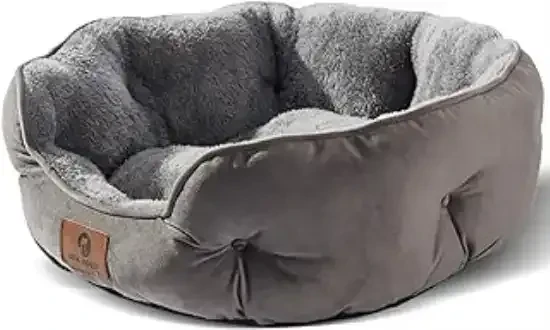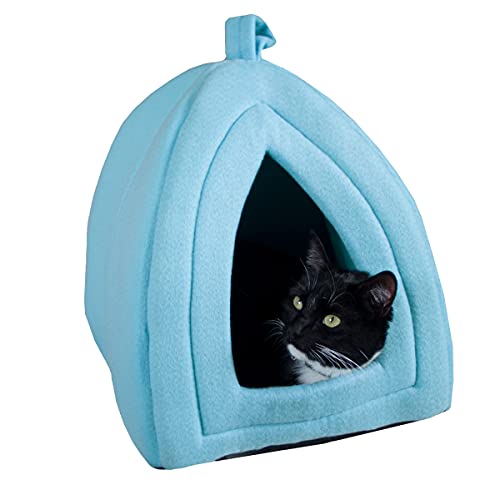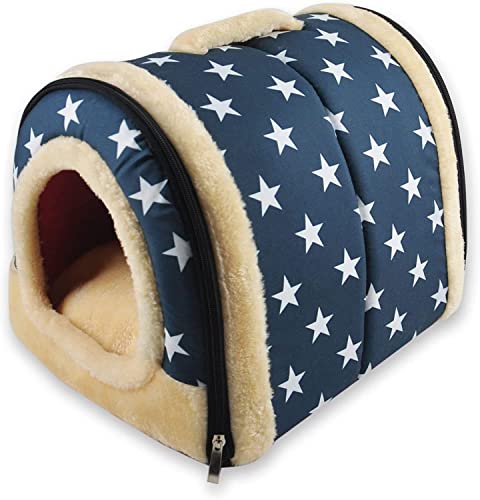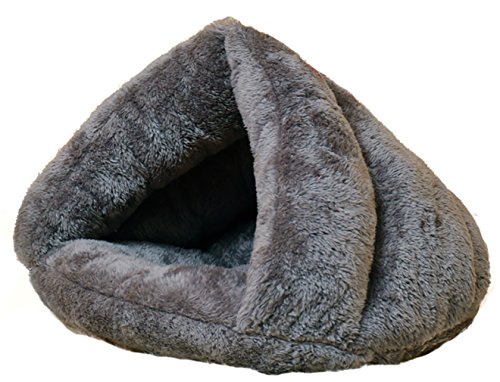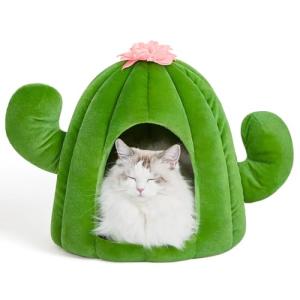Is your feline friend currently claiming prime real estate on your favorite armchair, or perhaps curling up in a cardboard box that seems decidedly less than luxurious? Do you find yourself tiptoeing around a sleeping cat nestled precariously on the edge of the sofa, or wincing as they settle down on a cold, hard floor? If so, it might be time to consider a dedicated, comfortable cat bed. While cats are renowned for their ability to find cozy napping spots in the most unexpected places, providing them with a proper bed is far more than just an act of pampering. It's an essential element of feline care that significantly impacts their comfort, security, and overall well-being. Stepping into the pet store or browsing online for cat beds can quickly become overwhelming. The sheer variety is astounding – bolster beds, donut beds, cave beds, heated beds, window perches, and more! How do you possibly choose the perfect one for your beloved kitty amidst this bewildering array of options?
This ultimate guide is designed to demystify the process of choosing the ideal cat bed for your feline companion. We'll navigate through the different types of cat beds available, exploring their unique features, benefits, and drawbacks. We'll delve into the crucial cat-centric factors to consider – from your cat's individual sleeping style and age to their health conditions and personality quirks. We'll also address practical considerations for you, the cat owner, such as space constraints, budget, and ease of cleaning. Ultimately, this guide aims to equip you with the knowledge and confidence to select a cat bed that truly resonates with your feline friend, creating a comfortable and inviting sleep sanctuary that they will happily claim as their own, enhancing their rest, security, and overall happiness within your home.
Providing your cat with a dedicated bed transcends simply giving them a place to sleep; it fulfills a range of fundamental needs that contribute to their physical and emotional well-being. One of the most significant benefits of a cat bed is the sense of security and ownership it provides. Cats are inherently territorial creatures, and having their own designated space is crucial for their comfort and confidence, especially in a domestic setting. A cat bed serves as their personal sanctuary, a haven where they can retreat to feel safe and secure, particularly in multi-pet households or busy homes with children or frequent visitors. This designated space becomes their own, a territory they can claim and control, offering a sense of stability and predictability in their environment. This territorial need is deeply rooted in their natural instincts. In the wild, cats seek out dens and sheltered spots as safe havens, providing protection from predators and the elements. A cat bed mimics this denning instinct, offering a similar sense of enclosure and safety within the home, fulfilling this primal need for a secure retreat.
Beyond security, a cat bed is essential for providing comfort and warmth. While cats are masters of finding warm spots, sleeping directly on hard floors or exposed furniture can be less than ideal, especially during colder months. A cat bed offers a cushioned and supportive sleeping surface, insulating them from cold floors and drafts. This is particularly crucial for senior cats, kittens, and cats with thin coats who are more susceptible to feeling the cold. Proper cushioning in a cat bed alleviates pressure points on their joints, muscles, and bones, promoting better circulation and preventing discomfort that can disrupt their sleep. This is especially important for older cats or those with arthritis, where a supportive bed can significantly ease joint pain and improve their overall comfort and mobility.
A comfortable and secure cat bed directly promotes better sleep and rest. Just like humans, cats need adequate and restful sleep for optimal health and well-being. A comfortable bed in a safe location encourages cats to settle down and enter into a deeper, more restful sleep cycle. Quality sleep is intrinsically linked to overall health. During sleep, the body repairs and rejuvenates, the immune system strengthens, and stress hormones are regulated. Adequate rest is crucial for maintaining a healthy immune system, enabling your cat to fight off illness and infection more effectively. Furthermore, sufficient sleep plays a vital role in managing stress levels. A well-rested cat is generally calmer, less prone to anxiety, and better equipped to cope with daily stressors. Proper rest also contributes to a cat's energy levels and daytime activity. A cat who sleeps soundly at night is more likely to be energetic, playful, and engaged during their waking hours, leading to a more fulfilling and stimulating life.
A dedicated cat bed can also function as a stress and anxiety reducing refuge. For cats who are naturally shy, timid, or prone to anxiety, a safe and comfortable bed can be an invaluable asset. It provides a designated retreat where they can escape from overwhelming stimuli, loud noises, or stressful situations within the home. Having a secure and predictable space to retreat to can significantly help anxious cats cope with environmental changes, the introduction of new pets or family members, or even everyday household noises that might trigger their anxiety. Knowing they have a safe haven to escape to provides a sense of control and predictability in their environment, contributing to an overall sense of calm and well-being. A comfortable cat bed becomes more than just a sleeping spot; it becomes a sanctuary, a source of emotional security and a calming presence in their daily lives.
Lastly, while not the primary reason for providing a cat bed, it can offer some protection for your furniture. While a cat bed isn't a guarantee your cat will never sleep on your sofa, providing an appealing and comfortable alternative can significantly encourage them to choose their bed over your furniture. Cats are drawn to comfort, warmth, and soft surfaces. If their bed offers a more desirable sleeping experience than your armchair, they are far more likely to gravitate towards their own designated space. By offering a more attractive and comfortable alternative, you can subtly redirect their sleeping habits and potentially minimize the amount of cat hair and wear and tear on your furniture, especially if you choose a bed style and location that aligns with their natural preferences.
The world of cat beds is remarkably diverse, offering a bewildering array of styles, materials, and features. To navigate this landscape effectively, let's explore some of the most popular types of cat beds available: Bolster beds are a classic and widely appreciated choice, known for their raised, cushioned sides, or bolsters, that create a sense of security and offer excellent head and neck support. Often oval or round in shape, bolster beds are particularly ideal for cats who enjoy curling up when they sleep, appreciate having their head and neck supported, and crave a feeling of enclosure and security. Pros include the enhanced security and comfort provided by the bolsters, their plush and cozy nature, and the head and neck support they offer. However, cons to consider are that bolster beds can be less suitable for cats who prefer to sprawl out and the raised sides might feel too restrictive for some felines.
Donut beds, sometimes referred to as cuddler beds, take coziness to the next level. These beds are typically round and plush, featuring high, circular walls that are often incredibly soft and enveloping, resembling a donut shape. Donut beds are ideal for cats who adore burrowing, crave a feeling of being completely secure and "hugged," relish exceptionally soft and plush surfaces, and thrive in cooler climates as they provide excellent warmth. Pros include their unparalleled coziness and plushness, the exceptional sense of security and envelopment they offer, and their warmth-providing design, perfect for colder environments. Cons are that they can be too warm for hot climates or cats prone to overheating, they often offer less structured support compared to other bed types, and they may flatten over time with heavy use as the plush filling compresses.
For cats who truly value privacy and solitude, cave beds, also known as hooded beds, are an excellent option. These beds feature an enclosed structure with a roof or hood, creating a cave-like retreat that offers maximum privacy and darkness. Cave beds are ideal for shy, timid, or anxious cats who crave a secure and secluded space, cats who prefer dark and quiet environments for sleeping, and multi-pet households where a cat might need a dedicated, protected retreat. Pros are the unparalleled security and privacy they offer, making them perfect for sensitive cats, the dark and quiet refuge they provide, and their suitability for cats who naturally prefer to hide away when resting. Cons include potentially less ventilation due to the enclosed structure, which might not be ideal for warmer climates, the possibility that some cats may dislike feeling overly confined, and the fact that cleaning can be slightly more challenging due to the enclosed design.
When warmth is a priority, especially for older cats or those living in cold climates, heated cat beds are a game-changer. These beds incorporate built-in heating elements, either electric or self-warming materials, to provide extra warmth and comfort. Heated cat beds are ideal for senior cats, kittens, cats with arthritis or joint pain who benefit from therapeutic warmth, and cats living in colder climates or who simply prefer to be extra warm and cozy. Pros include the exceptional warmth they provide, which is particularly beneficial for senior cats and those with joint issues, the therapeutic warmth that can ease achy joints and muscles, and their overall comforting and cozy feel, especially during winter months. Cons for electric heated beds include the need for electricity and associated safety precautions, and the potential for overheating if the bed becomes too warm for some cats. Self-warming beds, on the other hand, rely on reflecting body heat and might be less effective in extremely cold conditions.
Conversely, for cats residing in warmer climates or those prone to overheating, cooling cat beds offer a welcome respite from the heat. These beds are designed with cooling gel, breathable fabrics, or elevated designs to help cats stay cool and comfortable in warm weather. Cooling cat beds are ideal for cats in hot climates, thick-coated breeds who naturally tend to overheat, cats who simply prefer cooler sleeping surfaces, and for use specifically during summer months or in warmer rooms. Pros include their effectiveness in preventing overheating, particularly in warm environments, the cool and refreshing sleeping surface they provide, and their benefit during hot summer months. Some cooling beds are self-cooling and require no electricity. Cons are that they may not be necessary or desired in cooler climates, some cats may not perceive them as “cozy” as plush beds during colder weather, and cooling gel beds can sometimes be punctured if the outer material is not sufficiently durable.
For cats who are avid observers and sun-worshippers, window perch beds offer the best of both worlds. These beds are ingeniously designed to attach directly to windows using suction cups or brackets, transforming a window into an elevated sleeping and viewing platform. Window perch beds are ideal for cats who are fascinated by looking out windows, love to bask in sunlight, and enjoy elevated vantage points. They are also excellent for homes with limited floor space. Pros include combining a comfortable bed with a stimulating view of the outside world, satisfying a cat's love of windows and sunbathing, saving valuable floor space, and providing an elevated vantage point from which they can survey their domain. Cons are that the suction cups require secure attachment and may occasionally fail over time, they might not be suitable for all window types or window frame materials, and they generally offer less privacy compared to other bed styles.
Hammock beds introduce an element of playful motion and unique style to the cat bed landscape. These beds are designed to hang or suspend, often from cat trees, chairs, or dedicated stands, creating a gentle swinging or cradling effect. Hammock beds are ideal for playful cats who might enjoy the gentle swinging motion, cats who naturally gravitate towards heights and elevated resting spots, homes that already have cat trees or suitable furniture for hammock attachment, and owners seeking a more unique and visually interesting bed style. Pros include their elevated and airy design, the gentle swinging motion that some cats find soothing and enjoyable, their ability to be attached to existing cat furniture, and their unique and fun aesthetic. Cons are that not all cats enjoy the swinging motion and may find it unsettling, they often require specific furniture or structures for secure attachment, and they can sometimes be less stable than floor-based beds.
Finally, for cats who prefer simplicity and versatility, flat beds, also known as pillow beds or mats, are a practical and adaptable choice. These beds are simple, flat, cushioned pads without sides or enclosures, resembling oversized pillows or mats. Flat beds are ideal for cats who sprawl out when sleeping, cats who prefer warmer environments and less insulation, owners seeking a versatile and easily portable bed, and for use in warmer seasons or warmer locations within the home. Pros include their versatility, making them easy to place anywhere in the home, their suitability for cats who like to sprawl out or change sleeping positions frequently, their generally more affordable price point compared to more structured beds, and their ease of cleaning and portability. Cons are that they offer minimal security or enclosure, they provide less warmth than sided beds, and they might be less appealing to cats who instinctively seek out enclosed or more structured sleeping spaces.
When the time comes to choose the perfect cat bed, considering your cat's individual preferences and needs is paramount. Start by becoming a keen observer of your cat's sleeping style and preferences. Pay attention to their current sleeping habits. Do they habitually curl up in tight balls, stretch out fully in sunbeams, burrow under blankets, gravitate towards elevated spots, or prefer sleeping on flat surfaces? Note their preferred sleeping positions. Do they sleep primarily on their side, on their back with paws in the air, curled up tightly in a ball, or stretched out on their belly? Once you have a good understanding of their established sleeping patterns, match the bed type to their style. Cats who are curlers might naturally gravitate towards bolster beds or donut beds that offer a sense of enclosure. Sprawlers might be more comfortable on flat beds or mats that allow them to stretch out fully. Cats who love to burrow might be thrilled with a cave bed, while those who enjoy heights might prefer a window perch or hammock bed.
Your cat's age is another crucial factor to consider. Kittens require beds that are warm, cozy, and, above all, safe. Choose beds with lower sides for easy entry and exit, and prioritize durable and washable materials to withstand inevitable kitten accidents. Adult cats typically have more established preferences, so observe their individual style and choose a comfortable and supportive bed that aligns with their sleeping habits. Senior cats have unique needs that prioritize comfort and accessibility. Warmth becomes increasingly important as they age, so heated beds or beds made of warmer materials can be incredibly beneficial. Orthopedic support is crucial to relieve pressure points and ease aching joints, making memory foam or orthopedic beds excellent choices. Easy accessibility is also paramount, so opt for beds with low entry points that senior cats can easily get in and out of without straining their joints.
If your cat has any health conditions, these must be carefully considered when choosing a bed. For cats with arthritis or joint pain, orthopedic beds with memory foam or supportive cushioning are not just a comfort, they are a necessity. These beds help to distribute weight evenly, relieve pressure points on joints, and significantly improve comfort and reduce pain during sleep. Heated beds can also provide soothing warmth that eases joint stiffness and discomfort. For cats with respiratory issues, elevated beds or window perches can be beneficial as they promote better airflow and reduce exposure to dust and allergens that might accumulate near floor level. Avoid beds made with very fluffy or shedding materials if allergies are a concern for you or your cat. For cats prone to anxiety, enclosed beds like cave beds or donut beds offer a crucial sense of security and privacy, helping them feel safe, shielded, and less exposed to stressors in their environment.
Your cat's personality and temperament also play a role in bed selection. Shy or timid cats generally thrive in enclosed beds like cave beds, as these offer the security and privacy they crave, making them feel safe and less vulnerable. Confident and social cats, on the other hand, might prefer more open beds or window perches, as they enjoy observing their surroundings and being part of the household activity. Playful cats might be drawn to hammock beds or beds placed near interactive toys, creating a combined sleep and play zone. Finally, consider your cat's environmental preferences. Sun-seeking cats will adore window perch beds that allow them to bask in sunlight. Warmth-seeking cats will appreciate heated beds, plush donut beds, or bolster beds made of warmer materials. Coolness-seeking cats, in contrast, might prefer cooling beds, elevated beds that promote airflow, or flatter mats made of breathable materials. Think about where your cat typically chooses to sleep – in quiet, secluded spots or in more social, active areas of the home – and place their new bed in a location that aligns with these established preferences for optimal acceptance.
Beyond cat-centric considerations, practical factors for you, the cat owner, are also important to evaluate. Size and space in your home are crucial practicalities. The cat bed should be appropriately sized for your cat – large enough for them to comfortably stretch out or curl up in their preferred sleeping position, but not excessively large if you are limited on space. Measure the available space where you intend to place the bed to ensure the chosen bed type and size will fit comfortably without being obstructive or creating clutter. If you are considering a window perch bed, carefully assess your window size and strength to ensure secure and safe attachment of the bed.
Material and durability are essential for both longevity and your cat’s well-being. Always choose pet-safe materials, ensuring the fabrics, fillings, and construction are non-toxic and safe for your cat. Select durable materials that can withstand typical cat behaviors like scratching, kneading, and occasional chewing. For ease of maintenance and hygiene, prioritize washability. Beds with removable, machine-washable covers are highly recommended, allowing for easy cleaning of pet hair, dander, and occasional accidents. Consider material breathability, especially if you live in a warmer climate or your cat tends to overheat easily. Breathable fabrics will promote better airflow and prevent them from becoming too hot while sleeping.
Style and aesthetics are also considerations for many owners. Cat beds are now available in a wide array of styles, colors, and patterns, allowing you to choose one that complements your home décor and personal style. While aesthetics are important, always prioritize cat comfort and functionality over purely visual appeal. The most stylish bed is useless if your cat refuses to sleep in it! Consider the placement and visibility of the bed within your home when choosing a style. A bed placed in a prominent living area might warrant a more aesthetically pleasing design, while a bed tucked away in a quieter room might prioritize function over form.
Budget is always a practical factor. Cat beds range significantly in price, from basic flat mats to more elaborate heated or orthopedic models. Determine your budget beforehand to narrow down your options and avoid overspending. Balance cost with quality and features. While a budget-friendly option might seem appealing initially, consider the long-term value and durability. Investing in a slightly more expensive, higher-quality bed that will last longer and provide better comfort may ultimately be more cost-effective in the long run. Finally, prioritize ease of cleaning and maintenance. As mentioned earlier, removable and machine-washable covers are essential for hygiene and easy cleaning. Consider the general maintenance requirements of different materials. Some plush fabrics might require more frequent fluffing to maintain their shape. Check if replacement covers or cushions are available for the bed you choose, as this can significantly extend its lifespan and maintain hygiene over time.
Once you've selected the perfect cat bed, the final step is introducing it to your feline friend and encouraging its use. Strategic placement is key to initial acceptance. Observe your cat’s current sleeping habits and identify their preferred sleeping locations within your home. Place the new bed in an area where they already naturally like to sleep or spend time, such as a sunny spot, a quiet corner, or near where you spend time. Start by placing the bed in a location your cat is already comfortable with and gradually move it if needed based on their evolving preferences and how they interact with the bed. Initially, avoid placing the bed too close to their litter box or food and water bowls, as cats often prefer separate areas for sleeping, eating, and elimination.
To make the bed more enticing, use cat-approved attractants. Lightly spray the bed with catnip spray (if your cat responds to catnip) to attract their attention and create a positive association. Place a blanket or t-shirt that carries your scent on the bed. Your familiar scent can make the bed feel more secure and comforting to your cat. Toss a few treats or place their favorite toys near or on the bed to further create positive associations and encourage exploration. Use positive reinforcement. When your cat approaches, sniffs, or explores the bed, offer praise in a calm and gentle voice and reward them with petting or small treats to reinforce their positive interaction. Patience and gradual introduction are essential. Don’t force your cat into the bed. Allow them to investigate and explore it at their own pace. Avoid picking them up and placing them directly in the bed, as this can create negative associations and make them wary of it. Give it time. It may take days or even weeks for your cat to fully accept and consistently use the new bed. Be patient and continue to use positive reinforcement and enticing elements. If your cat doesn't seem interested in the bed in its initial location, don’t be afraid to experiment with moving it to other preferred spots within your home.
Finally, maintain the bed’s appeal over time. Regularly clean the bed cover by washing it frequently to remove pet hair, dander, odors, and dust mites, keeping it fresh and inviting for your cat. Fluff and reshape the bed regularly, especially for plush beds, to prevent it from becoming flattened and uncomfortable with use. And, eventually, be prepared to replace the bed when it becomes worn out, flattened, loses its shape and support, or is no longer appealing or comfortable for your cat. Providing a consistently clean, comfortable, and inviting sleep sanctuary ensures your cat continues to enjoy and benefit from their dedicated space.
Choosing the perfect cat bed is a significant investment in your feline companion's comfort, security, and overall well-being. It’s an act of love that extends beyond mere pampering, directly contributing to their physical and emotional health. By carefully considering the various bed types available, paying close attention to your cat's individual preferences, and factoring in practical owner-centric considerations, you can confidently navigate the often-overwhelming world of cat beds and select one that truly resonates with your feline friend. Embark on this rewarding journey to find the ideal sleep sanctuary for your cat, and delight in the satisfaction of witnessing them happily snoozing, purring contentedly, and enjoying the comfort and security of their perfect bed, a tangible expression of your care and devotion to their happiness and well-being.
